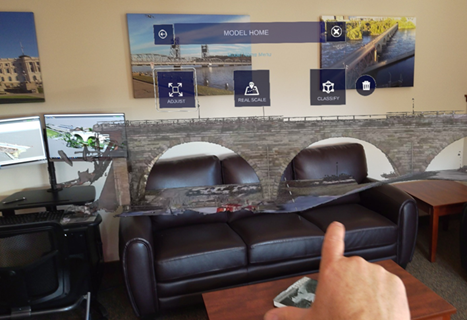Using drones to inspect bridges allows MnDOT to collect very high quality data while exposing fewer inspectors to far less risk and reducing inconvenience to the public. A new fleet of UAS will be used to conduct inspections statewide.
Commercial drones, or unmanned aircraft systems (UAS), have emerged as an efficient and powerful tool for bridge inspection. Historically, bridge inspections can be potentially dangerous and time-consuming. Inspectors have used ropes, climbing gear, ladders, lifts and under-bridge inspection vehicles to inspect under and above bridge decks. Inspections have required traffic control operations and lane closures to allow comprehensive assessments.
Rapid advancements in drone technology now offer the potential for transportation agencies to enhance bridge inspection methods with fast, efficient UAS data collection, employing sophisticated high-resolution image capture and reality modeling.
“As part of this research project, our team helped develop UAS technology and reality modeling software to create workflows that facilitate improved decision-making in managing bridges throughout their life cycle,” said Barritt Lovelace, regional manager, Collins Engineers, Inc.
Through three previous research projects addressing the use of drones for bridge inspection, MnDOT’s Bridge Office has gained knowledge of UAS capabilities and developed expertise in their use. The Phase I project established UAS value for bridge inspection, while Phase II tested a model with expanded imaging features to examine larger and more complex structures. Phase III investigated the capabilities of a collision-resistant UAS for operating in confined spaces; it also calculated cost-effectiveness. With the current project, MnDOT has reached the point of implementation: deploying UAS in the field to inspect a variety of bridges.
What Was Our Goal?
The goal of this project was to implement UAS bridge inspections in MnDOT’s Metro District. Working with MnDOT engineers, investigators would devise plans to select bridges, and with fieldwork and safety plans in place, conduct official UAS bridge inspections in the field. A second objective was the creation of a UAS operations manual specific to bridge inspections.
What Did We Do?
Investigators summarized the investigations and progress made in the previous three drone research projects, tracing how consideration of drone use for bridge inspections had moved from whether it was possible to how and when it could be implemented.
Then they examined five UAS—Flyability Elios, Skydio, Parrot Anafi, Intel Falcon 8+ and Sensefly Albris—and compared their capabilities, providing an overview of drone features that bridge inspections required, as well as evidence of how quickly UAS technology has progressed. The overview highlighted features most appropriate and desirable for bridge inspection, such as:
- Collision tolerance (functional in confined spaces).
- High-resolution image capture.
- 3D real-time point cloud.
- Mixed reality inspection.
- Acceptable battery life.
Investigators then developed a list of bridges that would benefit from drone inspections based up parameters conducive to UAS use. They ranked all MnDOT Metro District bridges based on five characteristics: type of feature the bridge crossed (river or highway), average daily traffic (ADT), bridge type, a previous successful UAS inspection of the bridge and the National Bridge Inspection (NBI) bridge rating.
Bridges selected for the study were:
- St. Croix Crossing bridge (Unit 3): 3,365 feet, Trunk Highway 36 at Oak Park Heights.
- I-394 at Dunwoody Boulevardon and off ramps.
- Blatnik Bridge: 7,980 feet, crossing the St. Louis Bay between Duluth, Minnesota, and Superior, Wisconsin.
- Special hauling vehicle bridges: Selected from across the states, these bridges have corrugated metal pipe arches atop short masonry walls and timber box culverts.
- Tettegouche State Park Bridge: 383 feet with a 140-foot steel deck truss span, crossing the Baptism River.
- Stone Arch Bridge: 2,100 feet, an inspection and rehabilitation project of a landmark bridge with 22 stone arches in Minneapolis.
A UAS safety and operational manual was also developed for MnDOT bridge inspection.
What Did We Implement?
UAS inspections were conducted at the bridges. Investigators gathered data and also evaluated UAS performance, including notable strengths and weaknesses. Each bridge project included a detailed inspection and safety plan that addressed all needs and Federal Aviation Administration (FAA) and MnDOT Office of Aeronautics requirements.
Deliverables were prepared for each inspection and all completed as official inspections for the bridges. In most cases, teams of one FAA-certified engineer–pilot and one bridge engineer performed the inspections.
“The findings from three previous projects allow MnDOT to incorporate UAS as powerful and efficient tools,” said Jennifer Wells, state bridge inspection engineer, MnDOT Bridge Office. “This project implements all we have learned, providing high-quality data with considerable cost and time savings and reduced risk for MnDOT bridge inspectors.”
Rapid advances in drone technology since the Phase II project were evident. For example, the Blatnik Bridge was a part of the first research effort. During that inspection, a team of six people spent a week in the field and only covered a small portion of the main spans. In this implementation phase, the team completed the entire UAS inspection in less than one day with two people and gathered data for the entire main spans.
What Was the Result?
The implementation of UAS for bridge inspection was successful. Inspections were completed with fewer people in less time, and high-quality data was obtained without risk to staff or inconvenience to motorists. MnDOT acquired 33 new UAS in 2021 and will work toward developing a proficient statewide UAS fleet.
Related Links



2 thoughts on “Drone Technology Enhances Bridge Inspections”